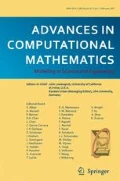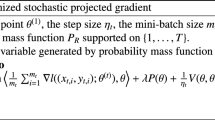Abstract
We consider a modification of Prony’s method to solve the problem of best approximation of a given data vector by a vector of equidistant samples of an exponential sum in the 2-norm. We survey the derivation of the corresponding non-convex minimization problem that needs to be solved and give its interpretation as a maximum likelihood method. We investigate numerical iteration schemes to solve this problem and give a summary of different numerical approaches. With the help of an explicitly derived Jacobian matrix, we review the Levenberg-Marquardt algorithm which is a regularized Gauss-Newton method and a new iterated gradient method (IGRA). We compare this approach with the iterative quadratic maximum likelihood (IQML). We propose two further iteration schemes based on simultaneous minimization (SIMI) approach. While being derived from a different model, the scheme SIMI-I appears to be equivalent to the Gradient Condition Reweighted Algorithm (GRA) by Osborne and Smyth. The second scheme SIMI-2 is more stable with regard to the choice of the initial vector. For parameter identification, we recommend a pre-filtering method to reduce the noise variance. We show that all considered iteration methods converge in numerical experiments.
Similar content being viewed by others
References
Adamjan, V.M., Arov, D.Z., Krein, M.G.: Analytic properties of the Schmidt pairs of a Hankel operator and the generalized Schur-Takagi problem. Math. USSR-Sbornik 15(1), 31–73 (1971)
Andersson, F., Carlsson, M., de Hoop, M.V.: Sparse approximation of functions using sums of exponentials and AAK theory. J. Approx. Theory 163, 213–248 (2011)
Andersson, F., Carlsson, M.: Fixed-point algorithms for frequency estimation and structured low-rank approximation. Appl. Comput. Harmon. Anal. 46(1), 40–65 (2019)
Bai, Z.D., Rao, C.R., Chow, M., Kundu, D.: An efficient algorithm for estimating the parameters of superimposed exponential signals. J. Statist. Plann. Inference 110(1), 23–34 (2003)
Beylkin, G., Monzón, L.: On approximation of functions by exponential sums. Appl. Comput. Harmon. Anal. 19, 17–48 (2005)
Beylkin, G., Monzón, L.: Approximation by exponential sums revisited. Appl. Comput. Harmon. Anal. 28, 131–148 (2010)
Bian, J., Peng, H., Xing, J., Liu, Z., Li, H.: An efficient algorithm for estimating the parameters of superimposed exponential signals in multiplicative and additive noise. Int. J. Appl. Math. Comput. Sci. 23(1), 117–129 (2003)
Boßmann, F., Plonka, G., Peter, T., Nemitz, O., Schmitte, T.: Sparse deconvolution methods for ultrasonic NDT. J. Nondestruct. Eval. 31, 225–244 (2012)
Braess, D., Hackbusch, W.: On the efficient computation of high-dimensional integrals and the approximation by exponential sums. In: DeVore, R.A., Kunoth, A. (eds.) Multiscale, Nonlinear and Adaptive Approximation. Springer, Berlin (2009)
Bresler, Y., Macovski, A.: Exact maximum likelihood parameter estimation of superimposed exponential signals in noise. IEEE Trans. Acoust., Speech, Signal Process. ASSP 34(5), 1081–1089 (1986)
Dogan, Z., Gilliam, C., Blue, T., Van de Ville, D.: Reconstruction of finite rate of innovation signals with model-fitting approach. IEEE Trans. Signal Process. 63(22), 6024–6036 (2015)
Dragotti, P.L., Vetterli, M., Blu, T.: Sampling moments and reconstructing signals of finite rate of innovation: Shannon meets Strang–Fix. IEEE Trans. Signal Process. 55, 1741–1757 (2007)
Feilat, E.A.: Prony analysis technique for estimation of the mean curve of lightning impulses. IEEE Trans. Power Del. 21(4), 2088–2090 (2006)
Golub, G.H., Pereyra, V.: The differentiation of pseudo-inverses and nonlinear least squares problems whose variables separate. SIAM J. Numer. Anal. 10(2), 413–432 (1973)
Hanke, M.: One shot inverse scattering via rational approximation. SIAM J. Imaging Sci. 5(1), 465–482 (2012)
Hua, Y., Sarkar, T.K.: On the total least squares linear prediction method for frequency estimation. IEEE Trans. Acoust. Speech Signal Process., ASSP 38(12), 2186–2189 (1990)
Ishteva, M., Usevich, K., Markovsky, I.: Factorization approach to structured low-rank approximation applications. SIAM J. Matrix Anal. Appl. 35(3), 1180–1204 (2014)
Kahn, M.H., Mackisack, M.S., Osborne, M.R., Smyth, G.K.: On the consistency of Prony’s method and related algorithms. J. Comp. Graph. Statist. 1, 329–349 (1992)
Kumaresan, R., Scharf, L.L., Shaw, A.K.: An algorithm for pole-zero modeling and spectral analysis. IEEE Trans. Acoust. Speech Signal Process. ASSP 34(3), 637–640 (1986)
Li, J., Stoica, P., Liu, Z.-S.: Comparative study of IQML and mode direction-of-arrival estimators. IEEE Trans. Signal Process. 46(1), 149–160 (1998)
Markovsky, I.: Low-Rank Approximation: Algorithms, Implementation, Applications, 2nd edn. Springer (2018)
Markovsky, I., Usevich, K.: Software for weighted structured low-rank approximation. J. Comput. Appl. Math. 256, 278–292 (2014)
Ortbandt, C., Dzienis, C., Matussek, R., Schulte, H.: Parameter estimation in electrical power systems using Prony’s method. J. Phys. 659(1), 012013 (2015)
Osborne, M.R.: Some Special nonlinear least square problems. SIAM J. Numer. Anal. 12, 571–592 (1975)
Osborne, M.R., Smyth, G.K.: A modified Prony algorithm for fitting functions defined by difference equations. SIAM J. Sci. Stat. Comput. 12, 362–382 (1991)
Osborne, M.R., Smyth, G.K.: A modified Prony algorithm for exponential function fitting. SIAM J. Sci. Comput. 16(1), 119–138 (1995)
Peter, T., Plonka, G.: A generalized Prony method for reconstruction of sparse sums of eigenfunctions of linear operators. Inverse Probl. 29, 025001 (2013)
Pisarenko, V.F.: The retrieval of harmonics from a covariance function. Geophys. J. Roy. Astron. Soc. 33, 347–366 (1973)
Plonka, G., Pototskaia, V.: Application of the AAK theory for sparse approximation of exponential sums. arXiv:1609.09603 (2016)
Plonka, G., Tasche, M.: Prony methods for recovery of structured functions. GAMM-Mitt. 37(2), 239–258 (2014)
Plonka, G., Potts, D., Steidl, G., Tasche, M.: Numerical Fourier Analysis. Springer (2019)
Potts, D., Tasche, M.: Nonlinear approximation by sums of nonincreasing exponentials. Appl. Anal. 90, 609–626 (2011)
Potts, D., Tasche, M.: Parameter estimation for nonincreasing sums by Prony-like methods. Linear Algebra Appl. 439(4), 1024–1039 (2013)
Roy, R., Kailath, T.: ESPRIT estimation of signal parameters via rotational invariance techniques. IEEE Trans. Acoust. Speech Signal Process 37, 984–995 (1989)
Schmidt, R.O.: A signal subspace approach to multiple emitter location and spectral estimation, PhD thesis, Stanford University (1981)
de la O Serna, J.A.: Synchrophasor estimation using Prony’s method. IEEE Trans. Instrument. Measur. 62(8), 2119–2128 (2013)
Skrzipek, M.-R.: Signal recovery by discrete approximation and a Prony-like method. J. Comput. Appl Math. 326, 193–203 (2017)
Therrien, C.W., Velsaco, C.H.: An iterative method for ARMA signal modeling. IEEE Trans. Signal Process. 43(1), 358–361 (1995)
Usevich, K., Markovsky, I.: Variable projection for affinely structured low-rank approximation in weighted 2-norms. J. Comput. Appl. Math. 272, 430–448 (2014)
Acknowledgements
The authors would like to thank the reviewers for many valuable suggestions to improve this manuscript essentially.
Funding
This work was funded by the NSFC (11571078), by a CSC Scholarship, and by the German Research Foundation within the framework of the RTG 2088.
Author information
Authors and Affiliations
Corresponding author
Additional information
Communicated by: Tomas Sauer
Publisher’s note
Springer Nature remains neutral with regard to jurisdictional claims in published maps and institutional affiliations.
Rights and permissions
About this article
Cite this article
Zhang, R., Plonka, G. Optimal approximation with exponential sums by a maximum likelihood modification of Prony’s method. Adv Comput Math 45, 1657–1687 (2019). https://doi.org/10.1007/s10444-019-09692-y
Received:
Accepted:
Published:
Issue Date:
DOI: https://doi.org/10.1007/s10444-019-09692-y
Keywords
- Prony method
- Nonlinear eigenvalue problem
- Nonconvex optimization
- Structured matrices
- Nonlinear structured least squares problem




